| Lahemaa National Park | |
|---|---|
 Viru Bog (Estonian: Viru raba) | |
 | |
| Location | Estonia |
| Coordinates | 59°34′16″N 25°48′1″E / 59.57111°N 25.80028°E |
| Area | 747 km2 (288 sq mi) |
| Established | 1 July 1971 |
| Website | Lahemaa National Park |
Lahemaa National Park is a park in northern Estonia, 70 kilometers east from the capital Tallinn. The Gulf of Finland is to the north of the park and the Tallinn-Narva highway (E20) is to the south. Its area covers 747 km2 (including 274.9 km2 of sea).[1][2] It was the first area to be designated a national park of the former Soviet Union. It is the largest park in Estonia and one of Europe's biggest national parks. Its charter calls for the preservation, research and promotion of North-Estonian landscapes, ecosystems, biodiversity and national heritage.
History
The name Lahemaa originates from the most thoroughly studied and visited part of the North Estonian coast, where four large peninsulas (Juminda, Pärispea, Käsmu and Vergi) are separated from each other by four bays (Kolga, Hara, Eru and Käsmu). Lahemaa translates roughly as "Land of Bays".[2]
The national park, established in 1971, is one of the main tourism drawcards in Estonia. Several companies offer day tour packages from Tallinn, while many people drive themselves.

With forests covering more than 70 percent of Lahemaa, the area is rich in flora and fauna. The landscape has many raised bogs, including the 7,000-year-old Laukasoo Reserve. The park, marked by several trails, teems with wildlife, including a population of boar, red deer, wolves, bear and lynx. The coast is covered with rocks and boulders, used each year by cranes as a stopover on their way to the Bosphorus and Egypt.[3]
There are four manors situated in the national park: Palmse manor, the picturesque Vihula manor, Kolga manor, and the baroque Sagadi Manor,[4] Estonia's most visited manor which together with the other three comprise one of the most unusual group of manors in the country.
Prior to 1991, the Soviet Union operated a large secret submarine base at Hara.[5] The base was built in the 1950s during the height of the Cold War.[5] The ruins of this former Soviet submarine base is now located entirely in Lahemaa near the Lahemaa lighthouse.[5]
Gallery
 The Viru Bog in autumn
The Viru Bog in autumn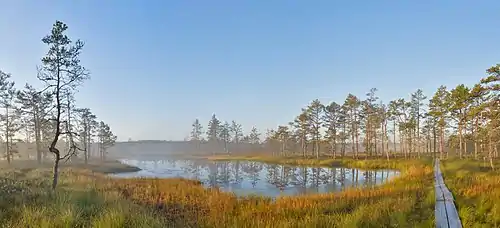 The bog at sunrise
The bog at sunrise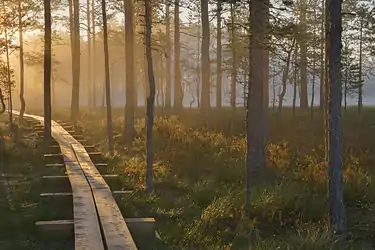 Wooden walkway near the bog
Wooden walkway near the bog The Altja River
The Altja River Nõmmeveski Falls
Nõmmeveski Falls The Valgejõgi River
The Valgejõgi River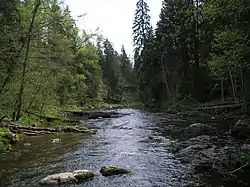 The Loobu River near Porgaste
The Loobu River near Porgaste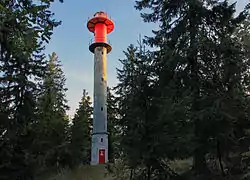
 Palmse Manor
Palmse Manor Fishermen's huts by the sea in the fishing village of Altja
Fishermen's huts by the sea in the fishing village of Altja Glacial boulders in Pärispea peninsula
Glacial boulders in Pärispea peninsula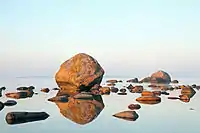 Glacial boulders with Mohni island in the skyline
Glacial boulders with Mohni island in the skyline Hauaneeme Bay in the village of Pärispea
Hauaneeme Bay in the village of Pärispea
See also
References
- ↑ Lahemaa Rahvuspark in Estonia Protected Planet
- 1 2 Estonica, Lahemaa National Park: from coastal drumlins to Kõrvemaa Archived 2007-06-10 at the Wayback Machine, Estonica, Encyclopedia About Estonia
- ↑ The Baltic coast, video by Free High-Quality Documentaries, on youtube.com. For Laheema national park, see 35'30 - 38'10. For the coastal boulders, see 35'38 - 35'48. For the cranes, see 35'48 - 38'10.
- ↑ Sagadi, Sagadi Manor, Retrieved 7 August 2012
- 1 2 3 Ryan (March 15, 2015). "Take a Look Inside These Abandoned Submarines & Bases". History in Orbit website. pp. 31–3. Archived from the original on April 17, 2018. Retrieved July 6, 2018.
External links
 Media related to Lahemaa National Park at Wikimedia Commons
Media related to Lahemaa National Park at Wikimedia Commons- Official website
- Lahemaa National Park in Estonica Archived 2020-04-29 at the Wayback Machine